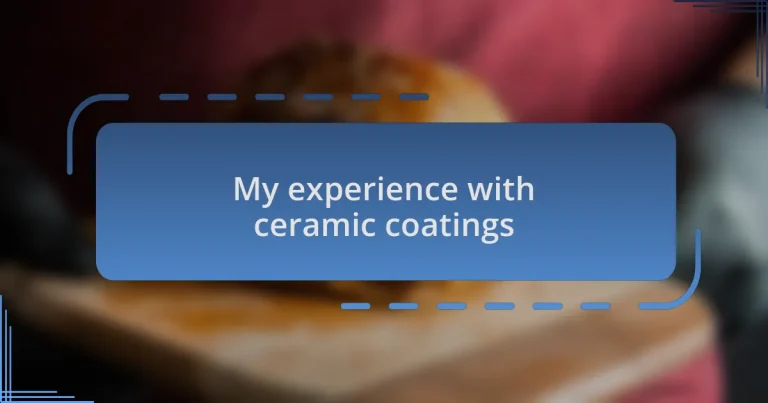Key takeaways:
- Ceramic coatings provide a protective barrier that enhances surface durability, reducing the need for frequent cleaning.
- Different types of ceramic coatings, such as consumer-grade and graphene-infused options, vary in durability and application suitability.
- Proper surface preparation and curing are crucial for achieving the best results when applying ceramic coatings.
- Regular maintenance, including gentle cleaning and periodic inspections, helps maintain the effectiveness and appearance of ceramic coatings.
Author: Olivia Hartwell
Bio: Olivia Hartwell is a contemporary fiction author known for her compelling narratives and vivid characterizations. With a background in literature and creative writing, she has a keen eye for detail and a passion for exploring the complexities of human relationships. Olivia’s debut novel, Whispers of the Heart, received critical acclaim and was nominated for several literary awards. When she’s not writing, she enjoys hiking in the mountains of Colorado and sipping artisanal coffee at local cafes. Olivia resides in Denver with her beloved rescue dog, Rosie.
Understanding ceramic coatings
Ceramic coatings are a revolutionary solution for protecting surfaces, especially in environments that see heavy use. When I first applied a ceramic coating to my truck, I was amazed at how it transformed not just the appearance but also the durability. This high-tech, liquid polymer bonds with the vehicle’s clear coat, creating a barrier that repels water, dirt, and even harsh chemicals.
I remember the first rain after applying the ceramic coating; the water just beaded off in beautiful droplets. It sparked a thought: why did I wait so long to invest in this? The beading effect is not just visually satisfying; it also means less time spent cleaning and more time enjoying the ride.
Understanding the science behind ceramic coatings can feel daunting at first, but it’s essentially about creating a protective layer that enhances the longevity of your surfaces. Have you ever wished for a solution that not only preserves your belongings but also makes them shine? That’s precisely what ceramic coatings offer—a perfect blend of aesthetics and functionality that can redefine how we view maintenance.
Benefits of ceramic coatings
Applying ceramic coatings brings numerous benefits that are hard to overlook. One significant advantage is their superior resistance to elements that can wear down surfaces over time. After coating my truck, I noticed how resilient it became against scratches and UV damage. It felt satisfying knowing that my investment was protected from the harsh sun and debris on the road.
Another benefit I experienced is the long-lasting shine. It’s like giving my truck a brand-new look that seems to last eternally. I often found myself admiring the gleam, almost like it was an invitation for spontaneous road trips just to show it off! Have you ever wished your vehicle looked freshly washed even after a few weeks? With ceramic coatings, that dream becomes a reality.
Lastly, the ease of maintenance is a game-changer. My cleaning routine changed dramatically; a quick wipe is often all it takes to keep my truck looking its best. I can’t help but think about how much time and effort I save now that I don’t have to scrub as hard or wash as often. Isn’t it reassuring to know that with a little upfront investment, you can enjoy a hassle-free experience down the line?
Types of ceramic coatings
When it comes to ceramic coatings, there are a few types that stand out. I’ve primarily used two: consumer-grade and professional-grade coatings. The consumer-grade options are more accessible for anyone wanting to tackle the application themselves but may not offer the same level of durability or protection as the professional-grade products. I remember the first time I tried a DIY ceramic coating. It was exciting, but I soon realized that the professional-grade products really do deliver a remarkable difference in resilience.
Another important distinction I’ve encountered is between traditional ceramic coatings and newer, graphene-infused options. Graphene coatings often add an extra layer of protection against harsh chemicals and even enhance the water-repelling properties. I was initially skeptical about trying a graphene-infused coating, but after applying it, I was taken aback by the level of bead formation when it rained. It’s like watching water dance off your surfaces, and that sense of satisfaction is hard to beat.
Additionally, I’ve noticed that some ceramic coatings come with specific formulations targeted toward certain applications, such as automotive, marine, or industrial uses. Each type is designed with particular conditions in mind, so understanding your specific need can greatly impact your choice. I often reflect on how crucial it is to select the right type for the specific surface I’m working with—after all, not every coating performs equally under the same circumstances. Wouldn’t you want to ensure you’re getting the best possible protection for your investment?
Application process for ceramic coatings
When it comes to applying ceramic coatings, preparation is key. I remember spending hours meticulously washing and decontaminating the surface before even opening the ceramic coating package. It’s amazing how a clean surface can dramatically enhance adhesion and overall performance. Skipping this step? That’s a mistake I made early on, and I quickly learned the hard way that even the best products can falter without the right groundwork laid.
Once the surface is prepped, I usually apply the coating in small sections, using a foam applicator. I’ll often think back to when I first tackled this alone; each swipe felt like I was unlocking a new level of protection. Focusing on working the product into the surface rather than just applying it hastily made a world of difference. Honestly, seeing the coating level up the appearance of my surfaces almost felt therapeutic—it’s like wrapping everything in a shiny, resilient armor.
After application, it’s important to allow the coating to cure properly. I’ve often found myself peeking at the surfaces, excited to see how the beads of water form and roll off. But I’ve also learned patience pays off; rushing this process compromises durability. It’s tempting to test it right away, but I remind myself that good things take time—much like waiting for that perfect burger to cook! Wouldn’t you agree that the anticipation only adds to the benefit?
My first application experience
The first time I applied a ceramic coating, I was both excited and anxious. I vividly remember how I nervously glanced at the bottles, wondering if I could really pull this off. As I started applying the first layer, my heart raced—would it actually look as good as the online tutorials promised?
I quickly noticed the way the coating transformed the surface right before my eyes, and that genuinely lifted my spirits. Each stroke felt like a small victory, and a sense of pride washed over me as I realized I was creating something special. It’s fascinating how a simple act of application can evoke such joy; have you ever felt that rush when trying something new and succeeding?
Finally, once I finished, I stood back and admired my work. The gleam of the newly coated surface made all the preparation worthwhile. I couldn’t help but smile, thinking about how this experience wasn’t just about protective coatings—it was a lesson in patience and resilience. Isn’t it amazing how some experiences stick with you long after they happen?
Tips for maintaining ceramic coatings
Maintaining ceramic coatings can seem daunting, but trust me, it’s simpler than it appears. One tip I always follow is to wash the surface regularly with a pH-neutral soap. The last thing you want is contaminants stuck on the coating, reducing its longevity and effectiveness. I remember the first time I skimped on a wash, and the coating lost some of its shine. Have you experienced something similar?
Another essential aspect is to avoid using abrasive materials during cleaning. I learned this the hard way when I used a rough sponge, thinking it would help scrub away grime. Instead, I ended up with micro-scratches marring the beautiful finish I worked so hard to achieve. Going forward, I switched to soft microfiber towels, and what a difference it made! Why risk damaging your coating when there are gentler options available?
Lastly, I’ve found that a quick inspection of the coating after cleaning helps catch any areas needing attention. This proactive approach has saved me from bigger problems down the line. I regularly check for missing spots and reapply as needed. Have you ever taken the time to evaluate your work? You’ll find that even small periodic checks can help retain that freshly coated look for a long time.
Final thoughts on ceramic coatings
When it comes to ceramic coatings, my experience leads me to believe they are worth every penny. The initial investment might seem steep, but I consider it an insurance policy for my vehicle’s finish. Have you ever noticed how a well-maintained exterior can turn heads? Having a shiny, protected surface has genuinely ramped up my pride in ownership.
I remember the first time I saw raindrops bead off my coated surface; it felt like magic. That hydrophobic effect is nothing short of satisfying, as it showcases the coating’s ability to repel dirt and grime efficiently. It sparked a newfound enthusiasm for keeping my car clean. Isn’t it exhilarating to see immediate results from your care?
Ultimately, ceramic coatings have transformed how I approach vehicle maintenance. I find it empowering knowing that my efforts pay off in long-lasting protection and aesthetic appeal. If you’re contemplating this journey, ask yourself: don’t you deserve to revel in that beauty and clarity every day?


